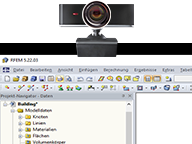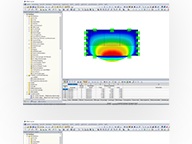RFEM 5 Add-on Module for Stability Analysis According to Eigenvalue Method
RF-STABILITY | Features
- Calculation of models consisting of member, shell, and solid elements
- Import of axial forces from a load case or combination
- Non-linear stability analysis
- Optional consideration of axial forces from initial prestress
- Four equation solvers for effective calculation of various structural models
- Optional consideration of stiffness modifications in RFEM
- Calculation of buckling modes of unstable models
- Determination of stability mode greater than the user-defined load increment factor (Shift method)
- Optional determination of the mode shapes of unstable models (to identify the cause of instability)
- Visualization of stability mode
- Basis for analysis using imperfect equivalent structures in RF-IMP
RF-STABILITY | Input
First of all, it is necessary to select a load case or combination whose axial forces are to be used in the stability analysis. It is possible to define another load case to, for example, For example, you have to consider an initial prestress.
Then, you can select the linear or non-linear analysis to be performed. Depending on the application, you can use a direct calculation method, such as according to Lanczos or the ICG iteration method. Members not integrated in surfaces are usually displayed as member elements with two FE nodes. It is not possible to determine the local buckling of single members on these elements. Therefore, you have the option to divide members automatically.
RF-STABILITY | Calculation
Several methods are available for the eigenvalue analysis:
- Direct Methods
- The direct methods (Lanczos, roots of characteristic polynomial, subspace iteration method) are suitable for small to medium-sized models. These fast methods for equation solvers benefit from a lot of the computer memory (RAM). 64-bit systems use more memory so that even bigger structural systems can be calculated quickly.
- ICG iteration method (Incomplete Conjugate Gradient)
- This method requires only a small amount of memory. Eigenvalues are determined one after the other. It can be used to calculate large structural systems with few eigenvalues.
The RF-STABILITY add-on module can also perform the non-linear stability analysis. Also for nonlinear structures, results close to reality are provided. The critical load factor is determined by gradually increasing the loads of the underlying load case until the instability is reached. The load increment takes into account nonlinearities such as failing members, supports and foundations, and material nonlinearities.
RF-STABILITY | Results
The first results presented are the critical load factors. This allows for an evaluation of stability risks. For member models, the effective lengths and critical loads of the members are output in tabular form.
In the next result windows, you can check the normalized eigenvalues sorted by node, member, and surface. The eigenvalue graphic allows for evaluation of the buckling behavior. The graphical display makes it easier to take countermeasures.
Calculate Your Price

The price is valid for United States.














.png?mw=192&hash=f63e4a3f1836233005de32f60201d5392e507cf1)



